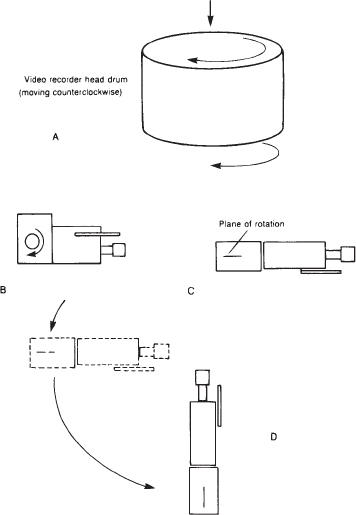Field conditions can make precision playback more difficult.
External Causes of Time Base Error
A VTR that spends all of its time in the studio will have relatively little time base error, assuming that the equipment is in good condition and properly used. But VTRs that are used in the field have an additional chance for time base error. Time base error can result from any change in the actual composition of the tape, generally owing to variations in air temperature, humidity, recorder position, and recorder movement. When a portable machine is used in the field, it is subjected to constantly changing conditions. It might be in the bright sun one minute and in the cool shade of a tree the next. You might be shooting at the fog-shrouded seashore in the morning and in the hot, dry desert later that afternoon. Changes in temperature and humidity will cause the tape to expand and contract. How might this result in time base error? Assume that you're shooting outside on a hot, sunny day. This will cause the tape to expand. After a hot afternoon of work, you return to the nice air-conditioned studio to edit the piece. The cool temperature of the studio causes the tape to contract. But even if the VTR could play back the tape at exactly the same speed as it was recorded, there would still be a problem. Since the tape has contracted, the video tracks have also contracted, so it will take a little less time for the head to scan them. Additional time base error has been created.
Gyroscopic Time Base Error
Gyroscopic time base error refers to the creation of time base problems specifically by changes in recorder position and movement. It's a very common occurrence given today's highly portable video equipment. Let's say that you've got one of those great camcorders that combine the camera and VTR in one unit. You have it up on your shoulder for some great shots, and then you swing around to follow the action. Gyroscopic time base error has been created. Gyroscopic error occurs because the spinning head drum in the VTR acts like a gyroscope. If you have ever played with a toy gyroscope or a spinning top, you know that if you try to move the toy against the plane of its rotation you will feel resistance. This is what happens inside the VTR. As the VTR is moved against the plane of rotation of the head drum, the spinning drum resists and slows down a little. When it slows down, the information will not be recorded at the proper speed. This is gyroscopic time base error. All of these factors determine how much time base error you might expect on tape playback. It could be less than a line in a studio machine, or it could add up to 20 or 30 lines (or more) on a field recorder!
Gyroscopic time base error. (A) Forces that move against the head drum's plane of rotation will cause gyroscopic error. (B) Side view of camcorder showing head drum and rotation. (C) Top view of the same camera showing the head drum's plane of rotation. (D) Gyroscopic error is caused when the head drum's plane of rotation is changed.

